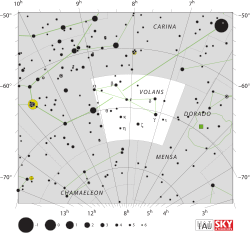Alpha Volantis

| |
| Observation data Epoch J2000.0 Equinox J2000.0 | |
|---|---|
| Constellation | Volans |
| Right ascension | 09h 02m 26.79592s[1] |
| Declination | −66° 23′ 45.8727″[1] |
| Apparent magnitude (V) | +4.00[2] |
| Characteristics | |
| Spectral type | kA3hA5mA5 V[3] |
| U−B color index | +0.13[2] |
| B−V color index | +0.14[2] |
| Astrometry | |
| Radial velocity (Rv) | +4.9[4] km/s |
| Proper motion (μ) | RA: −2.00[1] mas/yr Dec.: +95.51[1] mas/yr |
| Parallax (π) | 26.11 ± 0.12[1] mas |
| Distance | 124.9 ± 0.6 ly (38.3 ± 0.2 pc) |
| Details | |
| Radius | 1.9[5] R☉ |
| Surface gravity (log g) | 4.09[6] cgs |
| Temperature | 8,198[6] K |
| Metallicity [Fe/H] | +0.19[6] dex |
| Rotational velocity (v sin i) | 30.6±0.4[7] km/s |
| Age | 427+183 −377[8] Myr |
| Other designations | |
Alpha Volantis (α Vol, α Volantis) is a binary star[10] system in the southern constellation Volans. It has an apparent visual magnitude of +4.00, which is bright enough to be seen with the naked eye. Based upon parallax measurements made with the Hipparcos spacecraft, it is located at a distance of 125 light years from the Sun. As of 2010, the two components of this system had an angular separation of 0.0318″ along a position angle of 286.9°. The magnitude difference between the two components is 0.1.[11]
The primary component is an Am star with a stellar classification of kA3hA5mA5 V.[3] This notation indicates the star has the weak Calcium II K-line of an A3 star, and the hydrogen and metallic lines of an A5 star.[12] It has an estimated age of 427 million years.[8] In 1992, it was found to be emitting an infrared excess, suggesting the presence of a circumstellar disk of dust.[13] However, subsequent observations have not born this out.[14]
References
- 1 2 3 4 5 van Leeuwen, F. (2007), "Validation of the new Hipparcos reduction", Astronomy and Astrophysics, 474 (2): 653–664, arXiv:0708.1752
 , Bibcode:2007A&A...474..653V, doi:10.1051/0004-6361:20078357.
, Bibcode:2007A&A...474..653V, doi:10.1051/0004-6361:20078357. - 1 2 3 Mermilliod, J.-C. (1986), "Compilation of Eggen's UBV data, transformed to UBV (unpublished)", Catalogue of Eggen's UBV data. SIMBAD, Bibcode:1986EgUBV........0M.
- 1 2 Gray, R. O.; et al. (July 2006), "Contributions to the Nearby Stars (NStars) Project: spectroscopy of stars earlier than M0 within 40 pc-The Southern Sample", The Astronomical Journal, 132 (1): 161–170, arXiv:astro-ph/0603770
 , Bibcode:2006AJ....132..161G, doi:10.1086/504637.
, Bibcode:2006AJ....132..161G, doi:10.1086/504637. - ↑ Wielen, R.; et al. (1999), Sixth Catalogue of Fundamental Stars (FK6). Part I. Basic fundamental stars with direct solutions (35), Astronomisches Rechen-Institut Heidelberg, Bibcode:1999VeARI..35....1W.
- ↑ Pasinetti Fracassini, L. E.; Pastori, L.; Covino, S.; Pozzi, A. (February 2001), "Catalogue of Apparent Diameters and Absolute Radii of Stars (CADARS) - Third edition", Astronomy and Astrophysics, 367: 521–524, arXiv:astro-ph/0012289
 , Bibcode:2001A&A...367..521P, doi:10.1051/0004-6361:20000451.
, Bibcode:2001A&A...367..521P, doi:10.1051/0004-6361:20000451. - 1 2 3 Gray, R. O.; et al. (July 2006), "Contributions to the Nearby Stars (NStars) Project: spectroscopy of stars earlier than M0 within 40 pc-The Southern Sample", The Astronomical Journal, 132 (1): 161–170, arXiv:astro-ph/0603770
 , Bibcode:2006AJ....132..161G, doi:10.1086/504637.
, Bibcode:2006AJ....132..161G, doi:10.1086/504637. - ↑ Díaz, C. G.; et al. (July 2011), "Accurate stellar rotational velocities using the Fourier transform of the cross correlation maximum", Astronomy & Astrophysics, 531: A143, arXiv:1012.4858
 , Bibcode:2011A&A...531A.143D, doi:10.1051/0004-6361/201016386.
, Bibcode:2011A&A...531A.143D, doi:10.1051/0004-6361/201016386. - 1 2 Song, Inseok; et al. (February 2001), "Ages of A-Type Vega-like Stars from uvbyβ Photometry", The Astrophysical Journal, 546 (1): 352–357, arXiv:astro-ph/0010102
 , Bibcode:2001ApJ...546..352S, doi:10.1086/318269.
, Bibcode:2001ApJ...546..352S, doi:10.1086/318269. - ↑ "alf Vol -- Double or multiple star", SIMBAD Astronomical Database, Centre de Données astronomiques de Strasbourg, retrieved 2016-09-02.
- ↑ Eggleton, P. P.; Tokovinin, A. A. (September 2008), "A catalogue of multiplicity among bright stellar systems", Monthly Notices of the Royal Astronomical Society, 389 (2): 869–879, arXiv:0806.2878
 , Bibcode:2008MNRAS.389..869E, doi:10.1111/j.1365-2966.2008.13596.x.
, Bibcode:2008MNRAS.389..869E, doi:10.1111/j.1365-2966.2008.13596.x. - ↑ Hartkopf, William I.; et al. (2012), "Speckle Interferometry at SOAR in 2010 and 2011: Measures, Orbits, and Rectilinear Fits", The Astronomical Journal, 143 (2): 19, Bibcode:2012AJ....143...42H, doi:10.1088/0004-6256/143/2/42, 42.
- ↑ Gray, Richard O.; Corbally, Christopher J. (2009), Stellar Spectral Classification, Princeton, New Jersey: Princeton University Press, p. 309, ISBN 978-0-691-12511-4.
- ↑ Cheng, K.-P.; et al. (September 1992), "Newly identified main-sequence A stars with circumstellar dust", Astrophysical Journal, Part 2 - Letters, 396 (2): L83−L86, Bibcode:1992ApJ...396L..83C, doi:10.1086/186522.
- ↑ Gáspár, András; et al. (May 2013), "The Collisional Evolution of Debris Disks", The Astrophysical Journal, 768 (1): 29, Bibcode:2013ApJ...768...25G, doi:10.1088/0004-637X/768/1/25, 25.